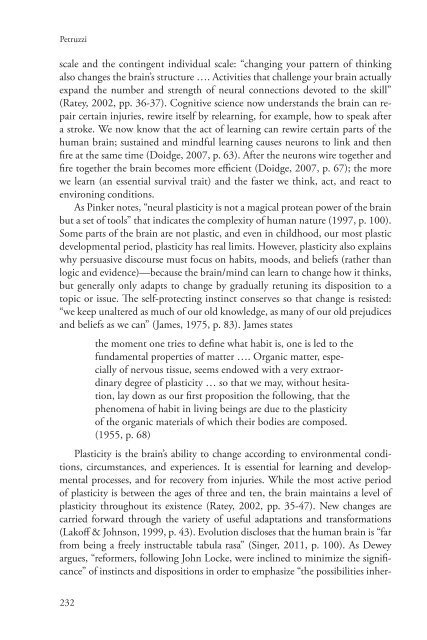Critical Expressivism- Theory and Practice in the Composition Classroom, 2014a
Critical Expressivism- Theory and Practice in the Composition Classroom, 2014a
Critical Expressivism- Theory and Practice in the Composition Classroom, 2014a
You also want an ePaper? Increase the reach of your titles
YUMPU automatically turns print PDFs into web optimized ePapers that Google loves.
Petruzzi<br />
scale <strong>and</strong> <strong>the</strong> cont<strong>in</strong>gent <strong>in</strong>dividual scale: “chang<strong>in</strong>g your pattern of th<strong>in</strong>k<strong>in</strong>g<br />
also changes <strong>the</strong> bra<strong>in</strong>’s structure …. Activities that challenge your bra<strong>in</strong> actually<br />
exp<strong>and</strong> <strong>the</strong> number <strong>and</strong> strength of neural connections devoted to <strong>the</strong> skill”<br />
(Ratey, 2002, pp. 36-37). Cognitive science now underst<strong>and</strong>s <strong>the</strong> bra<strong>in</strong> can repair<br />
certa<strong>in</strong> <strong>in</strong>juries, rewire itself by relearn<strong>in</strong>g, for example, how to speak after<br />
a stroke. We now know that <strong>the</strong> act of learn<strong>in</strong>g can rewire certa<strong>in</strong> parts of <strong>the</strong><br />
human bra<strong>in</strong>; susta<strong>in</strong>ed <strong>and</strong> m<strong>in</strong>dful learn<strong>in</strong>g causes neurons to l<strong>in</strong>k <strong>and</strong> <strong>the</strong>n<br />
fire at <strong>the</strong> same time (Doidge, 2007, p. 63). After <strong>the</strong> neurons wire toge<strong>the</strong>r <strong>and</strong><br />
fire toge<strong>the</strong>r <strong>the</strong> bra<strong>in</strong> becomes more efficient (Doidge, 2007, p. 67); <strong>the</strong> more<br />
we learn (an essential survival trait) <strong>and</strong> <strong>the</strong> faster we th<strong>in</strong>k, act, <strong>and</strong> react to<br />
environ<strong>in</strong>g conditions.<br />
As P<strong>in</strong>ker notes, “neural plasticity is not a magical protean power of <strong>the</strong> bra<strong>in</strong><br />
but a set of tools” that <strong>in</strong>dicates <strong>the</strong> complexity of human nature (1997, p. 100).<br />
Some parts of <strong>the</strong> bra<strong>in</strong> are not plastic, <strong>and</strong> even <strong>in</strong> childhood, our most plastic<br />
developmental period, plasticity has real limits. However, plasticity also expla<strong>in</strong>s<br />
why persuasive discourse must focus on habits, moods, <strong>and</strong> beliefs (ra<strong>the</strong>r than<br />
logic <strong>and</strong> evidence)—because <strong>the</strong> bra<strong>in</strong>/m<strong>in</strong>d can learn to change how it th<strong>in</strong>ks,<br />
but generally only adapts to change by gradually retun<strong>in</strong>g its disposition to a<br />
topic or issue. The self-protect<strong>in</strong>g <strong>in</strong>st<strong>in</strong>ct conserves so that change is resisted:<br />
“we keep unaltered as much of our old knowledge, as many of our old prejudices<br />
<strong>and</strong> beliefs as we can” (James, 1975, p. 83). James states<br />
<strong>the</strong> moment one tries to def<strong>in</strong>e what habit is, one is led to <strong>the</strong><br />
fundamental properties of matter …. Organic matter, especially<br />
of nervous tissue, seems endowed with a very extraord<strong>in</strong>ary<br />
degree of plasticity … so that we may, without hesitation,<br />
lay down as our first proposition <strong>the</strong> follow<strong>in</strong>g, that <strong>the</strong><br />
phenomena of habit <strong>in</strong> liv<strong>in</strong>g be<strong>in</strong>gs are due to <strong>the</strong> plasticity<br />
of <strong>the</strong> organic materials of which <strong>the</strong>ir bodies are composed.<br />
(1955, p. 68)<br />
Plasticity is <strong>the</strong> bra<strong>in</strong>’s ability to change accord<strong>in</strong>g to environmental conditions,<br />
circumstances, <strong>and</strong> experiences. It is essential for learn<strong>in</strong>g <strong>and</strong> developmental<br />
processes, <strong>and</strong> for recovery from <strong>in</strong>juries. While <strong>the</strong> most active period<br />
of plasticity is between <strong>the</strong> ages of three <strong>and</strong> ten, <strong>the</strong> bra<strong>in</strong> ma<strong>in</strong>ta<strong>in</strong>s a level of<br />
plasticity throughout its existence (Ratey, 2002, pp. 35-47). New changes are<br />
carried forward through <strong>the</strong> variety of useful adaptations <strong>and</strong> transformations<br />
(Lakoff & Johnson, 1999, p. 43). Evolution discloses that <strong>the</strong> human bra<strong>in</strong> is “far<br />
from be<strong>in</strong>g a freely <strong>in</strong>structable tabula rasa” (S<strong>in</strong>ger, 2011, p. 100). As Dewey<br />
argues, “reformers, follow<strong>in</strong>g John Locke, were <strong>in</strong>cl<strong>in</strong>ed to m<strong>in</strong>imize <strong>the</strong> significance”<br />
of <strong>in</strong>st<strong>in</strong>cts <strong>and</strong> dispositions <strong>in</strong> order to emphasize “<strong>the</strong> possibilities <strong>in</strong>her-<br />
232


















